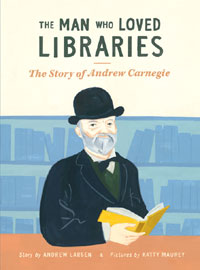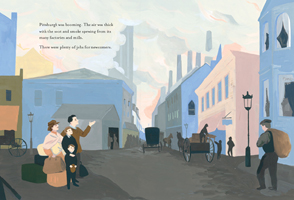| ________________
CM . . .
. Volume XXIV Number 27. . . .March 16, 2018

 |
The Man Who Loved Libraries: The Story of Andrew Carnegie.
Andrew Larsen. Pictures by Katty Maurey.
Toronto, ON: Owlkids Books, 2017.
32 pp., hardcover, $18.95.
ISBN 978-1-77147-267-8.
Subject Headings:
Carnegie, Andrew, 1835-1919-Juvenile literature.
Industrialists-United States-Biography-Juvenile literature.
Philanthropists-United States-Biography-Juvenile literature.
Carnegie libraries-Juvenile literature.
Grades 1-4 / Ages 6-9.
Review by Harriet Zaidman.
**½ /4
|
| |
|

excerpt:
Andrew knew that learning was the key to his future. He couldn’t go to school because he had to work. He could read, but books were expensive. Pittsburgh, like most cities at the time, didn’t have a public library where he could borrow books for free.
Luckily, there was someone who was interested in helping young workers to help themselves. Colonel Anderson, a local businesssman, opened the door to his own private library on Saturday afternoons.
This reviewer is one of hundreds of millions of people who have benefitted from the philanthropy of Andrew Carnegie. Going back three generations, members of my family read hundreds of thousands of dollars worth of books without spending a penny. We found our books at our nearest library, a building donated by the American industrialist that provided free public access to learning and enjoyment. Carnegie gave funds to a foundation that built a total of 2,509 libraries between 1883 and 1929. The Carnegie Foundation funded 1,689 libraries in the United States, 660 in the United Kingdom and Ireland, 125 in Canada, as well as libraries in Australia, South Africa, New Zealand, Serbia, Belgium, France, the Caribbean, Mauritius, Malaysia and Fiji.
 The library is a great equalizer. Income and social status don’t matter when it comes to borrowing books for free. Many people (my family included) advanced their status in life by learning from the public library. It’s not possible to calculate the value to society in monetary and social terms. The library is a great equalizer. Income and social status don’t matter when it comes to borrowing books for free. Many people (my family included) advanced their status in life by learning from the public library. It’s not possible to calculate the value to society in monetary and social terms.
It’s fitting, therefore, that a biography be written to teach young children about the important contribution Andrew Carnegie made to the world. Andrew Larsen (The Imaginary Garden, In the Tree House, See You Next Year) has summed up Carnegie’s life from his beginnings as the son of an impoverished weaver in rural Scotland across the Atlantic to the United States where he rose from the ranks of the poor through self-education and hard work to become one of the richest industrialists in the U.S. before he died in 1919.
Larsen’s narrative is simple and clear, and he appends further information about Carnegie’s largess at the end of the book. Indeed, it’s hard to imagine our cultural world without Carnegie Hall, considered to be one of the world’s most coveted concert halls in a performer’s career.
But Larsen makes only brief mention of how Carnegie became so wealthy (in today’s terms, he would be worth about $5 billion). In the body of the book he writes:
Andrew believed railroads were the key to the future. His first investment was with the Woodruff Sleeping Car Company. He went on to buy shares in companies producing oil and iron and steel, as well as those building the rails and bridges that were weaving their way across America. When they made money, he made money.
In the “Appendix”, he writes:
But his relationship with the workers in his own factories was complicated. Carnegie Steel Company clashed many time with employees who based together (or unionized) to fight for better wages, hours, and conditions. The company crushed the steel workers’ unions, and Andrew’s business thrived. But his reputation as a working-class-hero was never the same.
An important part of Andrew Carnegie’s legacy is a dark chapter in U.S. history. Carnegie was part of the American industrial aristocracy during the period of rapid industrialization and construction in the U.S. It was the “Golden Age,” but for whom? He and other tycoons, Andrew Mellon, John D. Rockefeller and others, gained enormous wealth through brutal exploitation of workers, people just like Carnegie’s father and mother who had suffered dire poverty and hunger while the owners of the factories got rich.
Most famously, Carnegie is known for smashing a strike and a union of workers in Homestead, PA, in 1892. Pinkerton guards, notorious mercenaries who were used against workers’ struggles, set upon the workers as did 8,000 militia ordered in by the state governor. Men were killed, and the strike was broken, putting the struggle for decent wages and working conditions back years, affecting the health and well-being of the workers and the ability of them and their descendants to become educated and better themselves. The Homestead strike has a significant place in history and merits more than the mention under the caption in the appendix.
Carnegie was unlike his fellow industrialists in that he really did give all his money away. His wife and daughter received a modest inheritance, and Carnegie was buried in a modest grave in Sleepy Hollow Cemetery in upstate New York. His modern descendants earn their own way.
Why did he donate nearly all his wealth to establish libraries, universities and other public institutions? Did he understand the contradiction between the way he suppressed hope in his employees and encouraged it through his philanthropy? Was his philanthropy his way of assuaging a guilty conscience? In 1889, he wrote “The Gospel of Wealth” where he stated: “The problem of our age is the proper administration of wealth, so that the ties of brotherhood may still bind together the rich and poor in harmonious relationship.” It’s hard to balance this philosophy with Carnegie’s real-life decisions.
Larsen doesn’t explore these questions. But if the intention of this biography is to educate children, he should expand on this critical part of Carnegie’s life. Other incidents connected to Carnegie, notably the Johnstown Flood in 1889, where more than 2000 people died when a dam broke, make him a more complicated personality than is presented.
 Katty Maurey’s soft, pastel illustrations complement the text well. Her uncomplicated pictures add information about how people lived at the time, their feelings subtly expressed merely by the way she positions their heads. The design of the book is pleasing and will appeal to children.
Katty Maurey’s soft, pastel illustrations complement the text well. Her uncomplicated pictures add information about how people lived at the time, their feelings subtly expressed merely by the way she positions their heads. The design of the book is pleasing and will appeal to children.
The Man Who Loved Libraries can be a valuable addition to a school library collection, but teachers who use it should include further information on Carnegie’s business activities to create a complete framework for children to understand his life.
Recommended with Reservations.
Harriet Zaidman is a retired teacher-librarian who signed out her first books at the St. John’s Library, one of three Carnegie libraries in Winnipeg, MB. The St. John’s branch is currently undergoing renovations to make it attractive and useful for future generations.

© CM Association
CC BY-NC-ND
Hosted by:
University of Manitoba
ISSN 1201-9364
|
This Creative Commons license allows you to download the review and share it with others as long as you credit the CM Association. You cannot change the review in any way or use it commercially.
Commercial use is available through a contract with the CM Association. This Creative Commons license allows publishers whose works are being reviewed to download and share said CM reviews provided you credit the CM Association. |
Next Review | Table of Contents for This Issue - March 16, 2018.
CM Home | Back Issues | Search | CM Archive | Profiles Archive
|

 The library is a great equalizer. Income and social status don’t matter when it comes to borrowing books for free. Many people (my family included) advanced their status in life by learning from the public library. It’s not possible to calculate the value to society in monetary and social terms.
The library is a great equalizer. Income and social status don’t matter when it comes to borrowing books for free. Many people (my family included) advanced their status in life by learning from the public library. It’s not possible to calculate the value to society in monetary and social terms.
 Katty Maurey’s soft, pastel illustrations complement the text well. Her uncomplicated pictures add information about how people lived at the time, their feelings subtly expressed merely by the way she positions their heads. The design of the book is pleasing and will appeal to children.
Katty Maurey’s soft, pastel illustrations complement the text well. Her uncomplicated pictures add information about how people lived at the time, their feelings subtly expressed merely by the way she positions their heads. The design of the book is pleasing and will appeal to children.